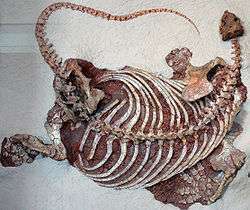Caseasauria
| Caseasaurs Temporal range: Late Carboniferous-Middle Permian, 306–272 Ma | |
|---|---|
 | |
| Fossil skeleton of Cotylorhynchus romeri | |
| Scientific classification | |
| Kingdom: | Animalia |
| Phylum: | Chordata |
| Clade: | Synapsida |
| Clade: | †Caseasauria Williston, 1912 |
| Genera and Families | |
Caseasauria is one of the two main clades of early synapsids, the other being the Eupelycosauria. Caseasaurs are currently known only from the Late Carboniferous[1] and the Permian, and include two superficially different families, the small insectivorous or carnivorous Eothyrididae, and the large, herbivorous, potentially aquatic[2] Caseidae. These two groups share a number of specialised features associated with the morphology of the snout and external naris.
The ancestor of caseasaurs can be traced back to an insect eating or an omnivorous reptile-like synapsid from the Pennsylvanian time of the Carboniferous, possibly resembling Archaeothyris, the earliest known synapsid. The caseasaurs were abundant during the later part of the Early Permian, but by the Middle Permian caseasaur diversity declined because the group was outcompeted by the more successful therapsids. The last caseasaurs became extinct at the end of the Guadelupian (Middle Permian).[3]
Phylogeny
Most uncertainty in the phylogeny of synapsids lies among the earliest members of the group, including forms traditionally placed within Pelycosauria. As one of the earliest phylogenetic analyses, Brinkman & Eberth (1983) placed the family Varanopidae with Caseasauria as the most basal offshoot of the synapsid lineage. Reisz (1986) removed Varanopidae from Caseasauria, placing it in a more derived position on the stem. While most analyses find Caseasauria to be the most basal synapsid clade, the analysis of Benson (2012) placed a clade containing Ophiacodontidae and Varanopidae as the most basal synapsids, with Caseasauria occupying a more derived position. Benson attributed this revised phylogeny to the inclusion of postcranial characteristics, or features of the skeleton other than the skull, in his analysis. When only cranial or skull features were included, Caseasauria remained the most basal synapsid clade. Below is a cladogram modified from the analysis of Benson (2012):[4]
| |
| |||||||||||||||||||||||||||||||||||||||||||||||||||||||||||||||||||||||||||||||||||||||||||||||||||||||||||||||||||||||||||||||||
| |
See also
References
- ↑ Robert R. Reisz and Jörg Fröbisch (2014). "The Oldest Caseid Synapsid from the Late Pennsylvanian of Kansas, and the Evolution of Herbivory in Terrestrial Vertebrates". PLoS ONE. 9 (4): e94518. doi:10.1371/journal.pone.0094518.
- ↑ Lambertz, M.; Shelton, C.D.; Spindler, F.; Perry, S.F. (2016). "A caseian point for the evolution of a diaphragm homologue among the earliest synapsids". Annals of the New York Academy of Sciences. doi:10.1111/nyas.13264.
- ↑ Maddin, H.C., Sidor, C.A. & Reisz, R.R. 2008. Cranial anatomy of Ennatosaurus tecton (Synapsida: Caseidae) from the Middle Permian of Russia and the evolutionary relationships of Caseidae. Journal of Vertebrate Paleontology (28): 160-180
- ↑ Benson, R.J. (2012). "Interrelationships of basal synapsids: cranial and postcranial morphological partitions suggest different topologies". Journal of Systematic Paleontology. in press. doi:10.1080/14772019.2011.631042.
- Reisz, R. R., 1986, Handbuch der Paläoherpetologie – Encyclopedia of Paleoherpetology, Part 17A Pelycosauria Verlag Dr. Friedrich Pfeil, ISBN 3-89937-032-5
- Laurin, M. and Reisz, R. R., 1997, Autapomorphies of the main clades of synapsids
External links
| Wikispecies has information related to: Caseasauria |
